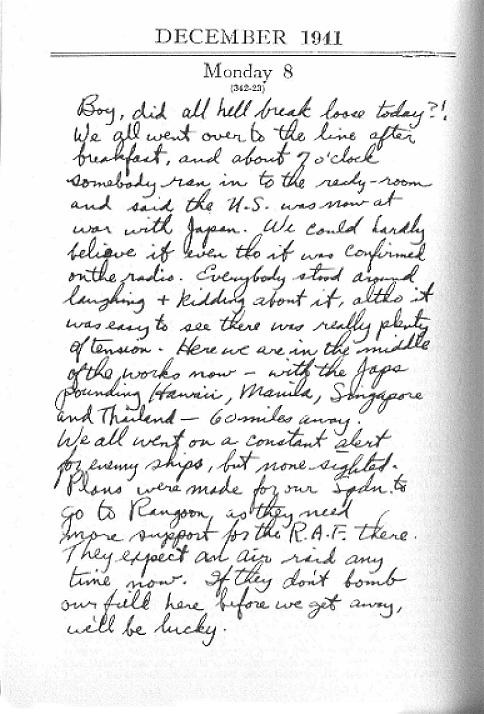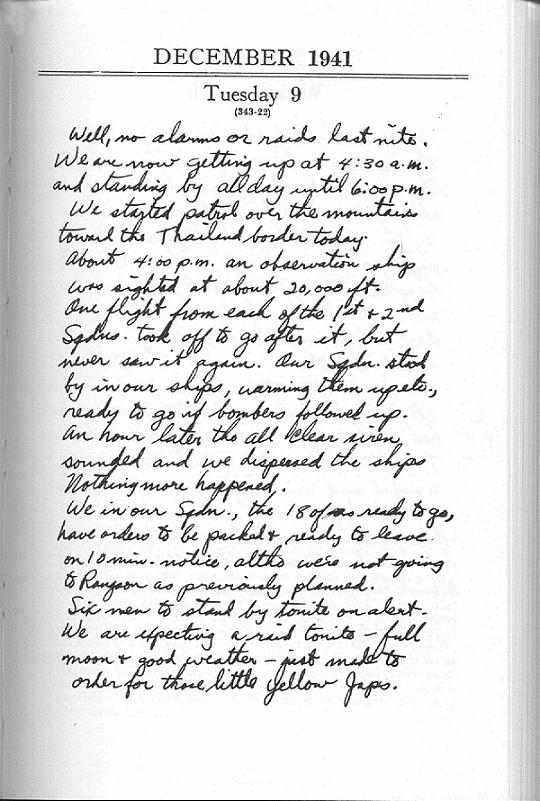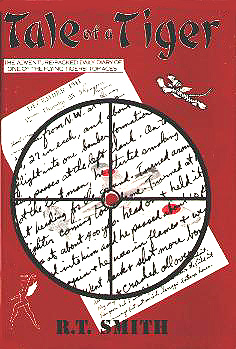
Create an Amazon Wedding Registry

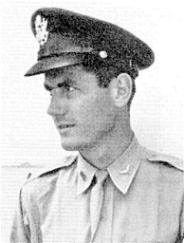
I'm not exactly sure why I decided to go ahead and do it at this late date. It's not that I believe there's a breathless public out there eagerly waiting to devour my words, nor do I expect to reap any significant financial reward from such a project. Perhaps it's because my excuses, except for laziness, are no longer valid. Certainly I now have plenty of time, and I have become more and more aware in recent years that there is still a surprising amount of interest in things having to do with the Flying Tigers, even among later generations. And while some of the many books that have been written about us give a reasonably accurate account from a historical viewpoint, in my opinion these third-person accounts often fail to capture the true picture of events that could be seen only through the eyes of a pilot and described in his own words. But perhaps the greatest incentive of all was that in the process of writing the book I would once again receive those hazardous and often desperate months in the company of that wild and wonderful little group of pilots and ground support personnel. Thinking of them, remembering the things we shared and endured, was bound to bring back a flood of vivid memories, both happy and sad. So far as am concerned, that in itself is reward enough.
Fortunately, I had kept a daily diary throughout the nine months spent in Burma and China during the brief existence of the AVG, so I figured much of the writing had already been done! could simply write a few introductory chapters, then copy those diary pages, add a few footnotes and photos, and Bingo! A book, just like that. Well, friends, it ain't been all that easy but it has been fun, and once I'd sunk my teeth into it I discovered I'm not even as lazy as I used to be.
Of course there is nothing new or unique about publishing a diary. In fact, I'm not even the first among Flying Tigers. Just a couple of years ago my good friend, Charley Bond, used such a format with his book, "A Flying Tiger's Diary," which I heartily recommend. Consequently, some of the same ground is of necessity covered by both of us, but I believe the reader will find that in many respects our stories differ greatly, primarily because we were in different squadrons and dealing with different people and circumstances. Bond flew with the 1st squadron, the "Adam & Eves" while I was a member of the "Hell's Angels," or third squadron.
In reading Charley's fine book, I was amazed to discover how little I really knew about the activities and individuals of his squadron despite having rubbed elbows off and on with them for several months. The reason was quite simple; once the AVG swung into combat action the three squadrons were seldom all together for more than very brief periods of time. while one squadron was fighting for its life in Rangoon, another might be enjoying relative inactivity in Kunming, while the third could be moving to still another base of operations in Burma or china. We were moved around like knights (or pawns, as some would have it) on a gigantic chessboard by our tough and crafty commander, Claire Lee Chennault. Even when a couple of squadrons shared the same base they had separate quarters and operations facilities, and more or less tended to stick together. Thus the closest bonds of friendship developed between members of the same squadron, much as might be the case with members of three different baseball teams within the same league.
And so, just as Bond has revealed many of the experiences that he and his comrades shared as members of the 1st squadron. I decided to do much the same from the perspective of the "Hell's Angels." And who knows, maybe some day someone from the 2nd ("Panda Bears") squadron will do likewise, for there are many intriguing stories yet untold, and all too few who feel inclined, or, are left to tell them.
I decided in the very beginning to make at least one rather unusual departure from the ordinary diary format, however. The actual pages of my diary, unedited, are reproduced here exactly as written in my own hand at the time. I thought that somehow this might make it more personal, and at the same time eliminate the temptation to delete or add comments or thoughts from the safe and sage perspective of hindsight. Within these pages such comments appear clearly as footnotes in printed form, or as what might otherwise be considered chapters before or between actual diary entries. I have also included a large number of photos. some of which have appeared in prior publications but many that have never before been seen by the public. Several of those that appear here in black and white are pictures that, were taken with Kodachrome film, and of course are less appealing than they appear in full color. I was most fortunate in this regard: so far as I know, I was the only one in the entire group to get any really good color pictures. So, having decided upon the make-up of the book. all that remained was to sit down at my typewriter and start banging away.
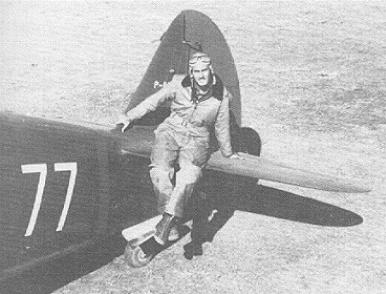
Perhaps I should start off with a real bang, that first combat action over Rangoon, Burma, on the 23rd of December, 1941, barely two weeks after the disaster of Pearl Harbor. I could begin by describing how it felt when I got that first glimpse of the enemy, and knew that within a couple of minutes I would get my first taste of war in the air I was in a flight of seven P-40s patrolling an area just east of Rangoon, with another flight of seven a couple of miles to the north. All eyes were nervously scanning the skies to the east; the British ground radar, not noted for its reliability of late, had reported a large number of enemy planes approaching from that direction, no doubt from bases in Thailand. Eventually one of us would spot them and then, following the standard reporting procedure and using code words prescribed by our limited training during the preceding weeks, would calmly announce his discovery over the radio. We would hear someone say something like, "Red leader from Red four, many Bandits at two o'clock low." Instead, a voice suddenly screamed, "Hey, Mac! I see the bastards! off to the right and a little below us, a whole slew of 'em." And sure enough, there they were, what appeared to be the entire Imperial Japanese Air Force, large specks in the distance, many clusters of them making up two huge formations of twin-engined bombers, with about thirty smaller specks, fighters, above and behind them. All heading in our direction and closing fast.
Suddenly I was aware of the pounding of my heart as my pulse rate doubled, chest heaving as I gulped pure oxygen from a slimy rubber mask at fifteen thousand feet, mouth full of cotton, the sudden and embarrassing urge to go to the bathroom, and another awe-struck voice coming through the headset, irreverently saying what all of us were thinking, "Jeezus Keerist!" Sounded like Tom Haywood, but I couldn't be sure, followed im-mediately by the calm voice of McMillan, our right leader, saying, "Okay, knock it off... check your gun switches... here we go!" just like he'd been doing this sort of thing every day for years. And then, moments later, one after another at regular intervals, our handful of little P-40s peeling off to attack, following Mac's lead as he dove toward the right flank of the first bomber formation and began firing. And now it was my turn, diving and turning to line up my gunsight with plenty of "lead" at a bomber, squeezing the stick-trigger and hearing the crackling sound of my four .30 caliber wing guns and the slower, powerful thudding of the two .50s in the nose, like twin jackhammers ripping up pavement; and the pungent smell of cordite filling the cockpit, a good smell. Now aware that dozens of guns from the bombers were firing back, tracers crisscrossing the sky in every direction, black smoke and flames streaming from the left engine of a bomber up ahead, and all the while that creepycrawly feeling at the back of the neck, knowing their fighters must surely be about to pounce down on us at any moment, sneaking up in the blind spot to the rear, set for the kill.
I have often been asked if I was "scared" that day, which is about like asking if McDonalds sells hamburgers. Let me tell you, friends, that anyone who claims he didn't feel any fear under such circumstances either (a) didn't fully understand the gravity of the situation, (b) is lying through his teeth, (c) is full of crap, or (d) all of the above! There is simply nothing quite like such an experience when it comes to getting the old adrenaline pumping while at the same time putting a severe strain on the bladder. No doubt you have heard athletes speak of having "butterflies in their stomach" before a big game, Imagine, then, a flock of buzzards flapping around down there just before the deadliest game of all is about to start, and you get the idea. Fortunately it lasts for only a few moments in most cases, after which things settle down to a state best described as semi-controlled panic.
Well, that first combat was the beginning of the shooting part of the story, but of course it fails to explain how we happened to be in that forsaken part of the world at that particular time; or how we got there, or why. Too much of a gap between the cow pasture and the macadam runways of Rangoon's Mingaladon aerodrome, as it were. So perhaps it would be best to back up about six months, back to Randolph Field, Texas, a few miles outside San Antonio. Since that is where I first learned of the embryo existence of what was to become known as the American Volunteer Group, I guess that's the logical place for a beginning.
Just a final thought before we get going; while I have been told by many people that my handwriting is quite legible, I am aware that now and then the reader may have to work at it a bit to decipher a particular word or passage appearing in the diary. My sincere hope is that he, or she, will find it worth the effort
R.T. SMITH
Please take note that Burma is on the other side of the International Date Line. Therefore, the actual date in the United States and Hawaii is one day behind Smith's diary entries. When the Japanese attacked Pearl Harbor on December 7th, it was already December 8th in Burma.
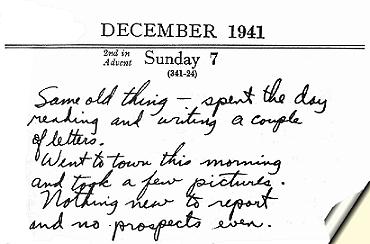
Dear Mom and Dad:
Your last letter received over a week ago, and of course I was delighted with the notes from all the Nebraska folks as well as your own.
I've been holding off in writing to you as I thought surely we'd be in China by now. We've been under instructions to be ready to leave on an hours notice for about ten days. All I can say is that we - half of us, at least are ready. There will be sixteen from my squadron flying up when we go, and about the same from the others. Naturally we're all anxious to get going, and irked at the delay.
There is no news to report here, except that the Englanders are reinforcing their borders. Things are getting tenser and tenser, but nobody knows what'll happen, or when. The Japs have been reported several times as having crossed the Thai border, but all these rumors have been denied. Of course if Thailand is invaded openly we will probably swing into action from here and never get to China. Makes no difference, just so we get to do - something!
On a lighter note, Paul and I have had a lot of fun showing up a few wise-guys who used to make nasty cracks about instructor-pilots. We don't hear any of that crap any more, and both know we can hold our own with anybody when it comes to flying these ships. We've each got about forty hours in them, and by now my P-40 feels as comfortable as an old pair of shoes My plane is No. 77, I've got a hell of a crew-chief and we're ready!
Sure hope you have a swell Christmas. I guess this will be the screwiest one I will ever see. Please tell everybody to write; you can't realize how much a letter means to somebody over here.
All my love to all,
Bob
Editors note:
The following diary pages reflect the events of December 7th (8th in
Burma) and the new urgency that is electrifying to the young men of the AVG.
